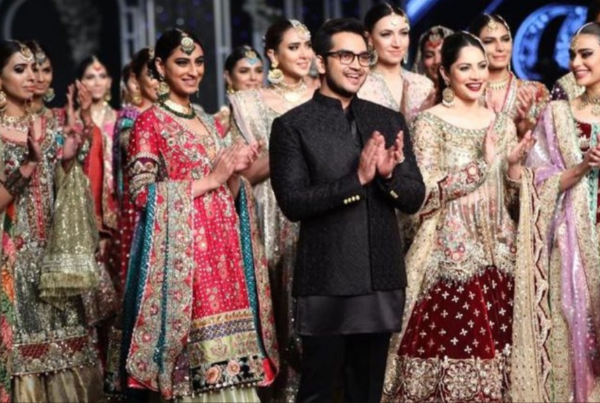There is more to the indigenous fashion scene than meets the eye. More so, internationally.
This sentiment was manifest at the 11th edition of Pakistan Fashion Week hosted at London’s historic Lancaster House over the last weekend. The two-day fashion event commemorated the 70th anniversary of Pakistan and attracted over 2,000 guests, who witnessed a catwalk run through three halls of the royal palace. According to people who attended in London (we weren’t there to witness it), envoys from a large number of embassies joined in the celebration.
A nine-room exhibition allowed the guests to interact with the designers and buy from their collections.
According to reports, the grand extravaganza showcased over 40 of Pakistan’s leading and emerging designers who presented their latest collections at the event. The designers included top names like Shamaeel Ansari, Sana Safinaz, Maria B, Maheen Khan and Umar Sayeed, along with a long list of upcoming brands. Leading Pakistani models Fouzia Aman and Eshal Fayyaz joined the pool of foreign models and sashayed down the ramp, flaunting a blend of designs and motifs.

Maheen Khan’s minimal pieces are definitely something that would appeal to an international audience.
Shamaeel Ansari, senior designer, who participated in the fashion week for the third consecutive season, underscored the value of such events for a market still developing in the West. When asked about her own brand, she commented that while she has exhibited her collections at Pakistan Fashion Week-London as well as Fashion Parade, that is not where they are sold.
“My outfits are more high-end but I feel it is important for events to take place outside Pakistan because the industry there has become completely skewed; there is no parameter and too many fashion weeks happening,†she spoke to us over the phone from London.
However, back home in Pakistan, she added, the industry was mushrooming beyond control. There was an explosion of new designers surfacing on social media and a litany of fashion weeks being held locally, dubbing the phenomenon a fashion fatigue.
She suggested a need for better quality control, where designers were more consistent and younger designers could figure out what works for the market in London.
People tend to think that Pakistani commodities are highly traditional, she added, although the collections she has showcased in London have been eclectic. “I’ve never gone for ghararas and cholis, saris or heavily-embroidered fabrics, it is important to see what is sustainable in the West.â€
Shamaeel’s intricately-patterned jackets, embellished and embroidered with a plethora of colours and textures exuded a trendy yet ethnic vibe. An east-meets-west style, that could work in any environment.
Adnan Ansari, organiser of the event, spoke about its success of running the fashion for over five years in a row. He also highlighted a growing clientele who witnessed and purchased directly from the designers, making for business-savvy deals.

Adnan Ansari, the organizer of the event
He quoted the acclaimed art critic Tim Marlow, who attended the event along with his wife, as likening Sana Safinaz’s prints on display to exquisite pieces of art.
Adnan, who seems optimistic about the future of the Pakistani fashion industry in London, mentioned how the event also enables the emerging designers to establish themselves in the market and give Londoners a flavour of what the industry has to offer. Moreover, he expressed gratitude over the collaboration with the Pakistan High Commission in organising the event.





